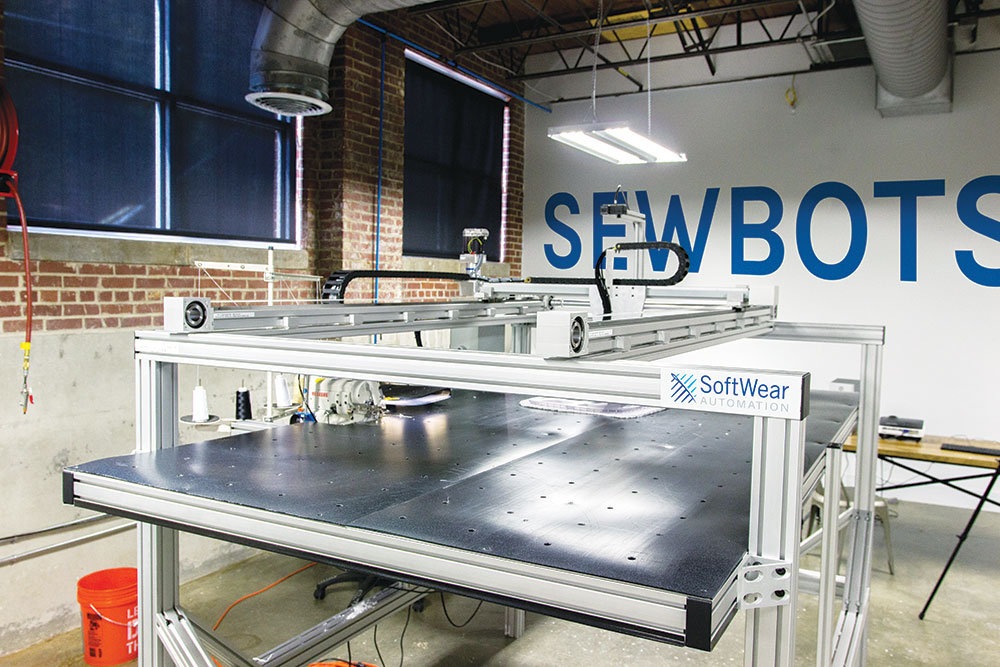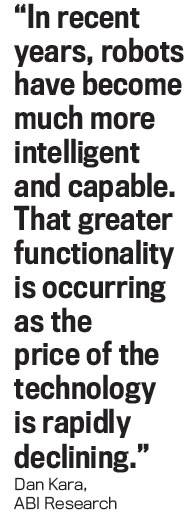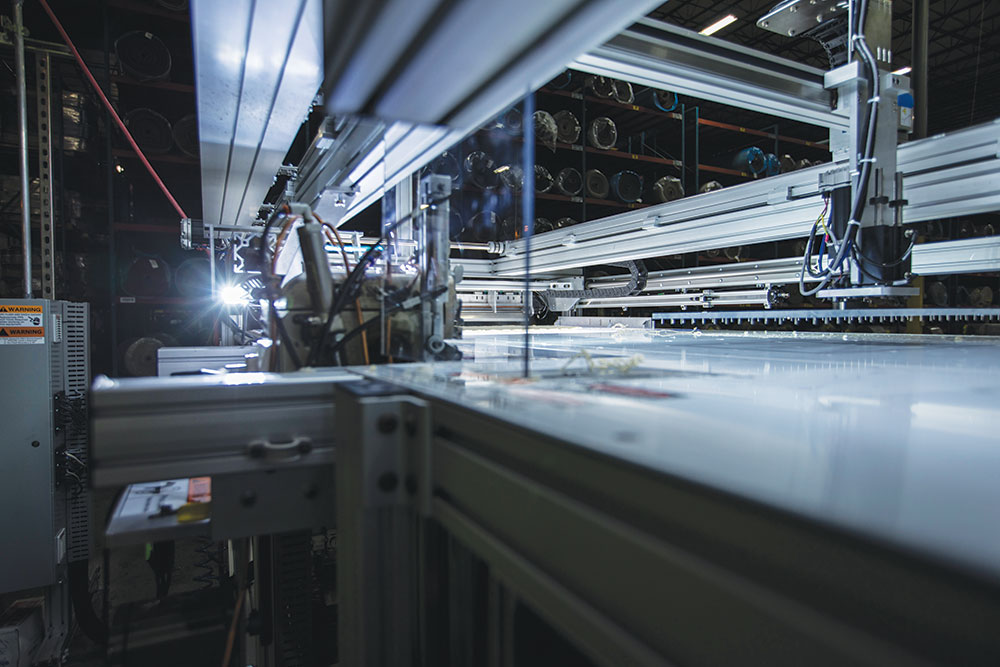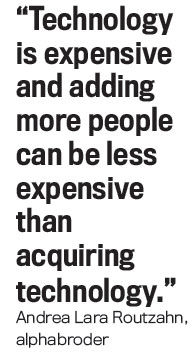January 15, 2018
The Sewbots Are Here
Robots capable of sewing finished garments could turn the current apparel manufacturing model on its head.
In a once-shuttered factory in Little Rock, AK, a potential robot revolution in the apparel industry is poised to launch. If things go as some artificial intelligence proponents envision, the robot-driven activities in the factory could one day be looked back on as early sparks that helped ignite a transformation in apparel manufacturing, supply chains and speed of delivery. That all could have significant implications for the promotional products industry, where apparel accounts for 39% of annual industry sales, according to SOI data.
Scheduled to be operational by the end of 2018, the plant is slated to feature fully automated T-shirt production lines powered by robots that have been given the headline-friendly name of Sewbots by their creators, Atlanta, GA-based SoftWear Automation.
While aspects of the apparel manufacturing process have already been automated, the Sewbots represent a possible game-changing leap forward. Despite computer-controlled fabric cutting equipment and other automated advancements, human hands have always been needed to work with machines to stitch and sew final garments. The reason? Cloth is floppy and moves unpredictably, making it difficult for robots, as so far developed, to work with the material and create finished apparel.
But now, using advanced machine vision, cutting-edge computing and robotic sewing, the Sewbots will be able to handle soft fabrics and actually “make” T-shirts, says SoftWear Automation CEO Palaniswamy Rajan. Indeed, China-based Tianyuan Garments Company, which owns the Arkansas plant, aims to produce massive volumes of tees for Adidas with the Sewbots.
“From fabric cutting and sewing to finished product, it takes roughly four minutes,” Tang Xinhong, chairman of Tianyuan Garments, recently told China Daily. “We will install 21 production lines. When fully operational, the system will make one T-shirt every 22 seconds.” Labor costs, Tang says, will be about 33 cents per shirt. “Around the world, even the cheapest labor market can’t compete with us,” he says, noting the plant’s operations will ultimately generate 400 new jobs in Arkansas.
Should Tianyuan and SoftWear Automation get it right, the ripple effect such a model could have on the apparel industry – and domestic manufacturing – is potentially far-reaching. Other AI innovators are laboring to invent robotic solutions that similarly aim to stir a seachange in the $3 trillion global apparel market. Here, Counselor explores the sci-fi-seeming evolution and examines what it could mean for the promo industry if robots start taking charge of garment sewing.
 SoftWear Automation’s Sewbots can make a T-shirt from start to finish in roughly four minutes.
SoftWear Automation’s Sewbots can make a T-shirt from start to finish in roughly four minutes.
Sewbots, Sewbo & the Speedfactory
SoftWear Automation and its Sewbots spun out of research at Georgia Tech’s Advanced Technology Development Center. In 2012, a grant from the Defense Department’s innovation branch – the Defense Advanced Research Projects Agency – helped accelerate the technological development and formation of fledgling startup SoftWear Automation to commercialize the bots.
While the autonomous work lines for apparel are set to debut this year, SoftWear Automation went to market in 2015 with robots that create a range of home goods, from bath mats and bath towels, to cushions and pillowcases. “Picture walking into a hotel room, and essentially anything that needs to be sewn in there, we can do,” says Rajan, noting his company sells its machines to production clients and does not make goods itself.
Going forward, Rajan sees big opportunity in apparel – not only with T-shirts, but eventually with jeans, too. “Right now we want to talk about what we know we can do really well, which is T-shirts,” says Rajan, whose firm plans to expand from 35 employees to more than 100 in 2018. “Down the line, as things evolve, we could be talking about more products,” Rajan says.
His isn’t the only company eager to pioneer a new age of robotic apparel production.
Inventor Jonathan Zornow wants to automate the garment construction process as well, but he’s coming at the issue from a different direction with his startup, Sewbo Inc. The forward-thinking millennial, a Brandeis University grad, has created a solution that overcomes the challenge robots face in working with limp, flexible fabrics. Zornow utilizes a plastic called Polyvinyl Alcohol, a non-toxic polymer used elsewhere in the textile production process, to temporarily stiffen fabrics. Once rigid, the fabrics can be manipulated before being permanently sewn together – actions that robots can complete as if they were working with sheet metal, says Zornow.
“The water-soluble stiffener is removed at the end of the manufacturing process with a simple rinse in hot water, leaving a soft, fully-assembled piece of clothing,” he says.
So far, Zornow has used an “off-the-shelf” industrial robot to sew a shirt – a feat he achieved by programing the bot to work with a sewing machine to build the garment with his polymer-treated fabric. While the Sewbo solution isn’t yet available commercially, a number of manufacturers are experimenting with the technology, though Zornow declined to say which ones. Part of that experimentation, which Zornow is also engaged in, focuses on hammering out the complicated particulars involved with refining robots and software so clothes can be produced efficiently in a real-world factory setting using his method.

“We’re focused on integration, on getting everything to work together so that the process is streamlined and seamless,” says Zornow, noting he’s raising money and pulling together teams for more research and development.
Elsewhere, household name brands are also eyeing enhanced automation for wearables production.
Amazon, for example, has earned a patent for an automated, computer-controlled system of on-demand apparel manufacturing, which will reportedly involve the design, printing, production, cutting and shipping of clothes. In the apparel-related footwear category, Nike has been benefitting from automation innovation via a partnership with Flex, a high-tech manufacturing company. At its Mexico facility, Flex has infused automation advancements – like automated gluing – into the process of making a shoe.
Not to be outdone, Adidas has thrown its hat into the ring of automated footwear production with its Bavaria-based Speedfactory, which uses robots, 3-D printing and other digital age innovations to make footwear. In October 2017, the Speedfactory began producing a series of small-batch sneakers – Adidas Made For (AM4). The series is specifically designed for six of the world’s biggest cities, including London, New York and Los Angeles. Adidas plans to establish a second Speedfactory in Atlanta. “Robotics is clearly the way of the future in apparel manufacturing,” says Eric J. Rubin, president of apparel company Blue Generation (asi/40653), a Top 40 supplier. “The benefits overall are tremendous on every level.”
Upsides for the Promo Industry
But just what are those benefits? And how could they help the promotional products industry?
For starters, finely tuned robots capable of building garments could one day lower the cost of creating clothes, while also accelerating the nuts-and-bolts process of assembling apparel. Furthermore, manufacturers could produce greater consistency in sizing and fit. “The ability to achieve consistency in some aspects of garment construction could be very beneficial for our industry, which requires highly consistent products and fits from year to year,” says Andrea Lara Routzahn, vice president of portfolio and supplier management at Top 40 supplier alphabroder (asi/34063).
Perhaps more tantalizingly, robots could play a central role in triggering a trend toward the onshoring of apparel production – as Tianyuan’s Arkansas plant bears testimony to. Rather than scrambling from one cheap labor nation to the next to keep manufacturing expenses down, apparel makers could rely on robots to cost-effectively create clothes in, or closer to, major market destinations, like the United States and Europe. That could lead to more domestic jobs in the U.S. Rajan estimates one SoftWear Automation T-shirt sew line will generate 50 to 100 jobs, up and down stream.
Even more specific to the business interests of suppliers and distributors, robot-fueled, U.S-based apparel manufacturing could dispel international shipping hassles, allow for more on-demand production, prove pleasing to clients eager for “Made-in-the-USA” labels and, maybe most importantly, enable clothes that tap into current trends to make it to market much faster, which could spur more lucrative sales to end-buyers.
“Speed to market is a term that is frequently tossed around, but being able to manufacture apparel in shorter lead times, in closer regions, means distributors can order more according to need, without keeping large stocks of inventory, which in our industry often become obsolete,” says Routzahn. “Obsolete inventory isn’t only expensive, but often is difficult to dispose of. Excess inventory is also a waste of natural resources.”
Expanding on Routzahn’s speed theme, John Thorbeck believes robots can play an important role in helping to propel a transformation that he believes fashion and apparel companies should be striving for – namely, the rapid acceleration of the clothing production cycle. The chairman of California-based Chainge Capital, a firm focused on improving global retailers and brands through merchandise speed and flexibility, says that bots could help engender a new model in which sourcing is reduced to just days, and where 12-month design cycles lessen to eight weeks or fewer.
“The goal isn’t just days off the calendar, but lower risk which can be quantified and monetized,” says Thorbeck. “These are non-incremental changes, a transformation versus improvement in performance. The right road is process innovation first, aided and accelerated by robotics.”
 The aim of Sewbots is to revolutionize apparel manufacturing by creating finished garments without a human seamstress.
The aim of Sewbots is to revolutionize apparel manufacturing by creating finished garments without a human seamstress.
Reality Check
But is it realistic to think these potential benefits will ever be realized? Certainly there are impediments. Start with technology. While SoftWear Automation has made exciting advancements, it remains to be proven if robots can deftly and efficiently sew together a range of apparel items at scale in a production setting. Nonetheless, robotics proponents believe that day is coming. “In recent years, robots have become much more intelligent and capable,” says Dan Kara, director of robotics research at ABI Research, a technology market intelligence company. “That greater functionality is occurring as the price of the technology is rapidly declining.”
Of course, economics are a huge factor. Not only will robots have to perform, they’ll have to be available at a cost that incentivizes apparel producers to invest. While difficult to say exactly when, some analysts believe the age of affordability will soon arrive – just as personal computers followed an era when computers took up whole rooms and could only be afforded by the military, corporations and universities.
“The apparel industry is often slow to move toward technology due to the availability of low-cost labor in under-developed countries,” Routzahn says. “Technology is expensive and adding more people can be less expensive than acquiring technology. That will change as the world moves toward better conditions for all its citizens. There will be a tipping point where investment in technologies makes sense.”
While promo industry apparel suppliers contacted for this article reported that they’re not currently seeing movement in their supply chains toward the introduction of garment-sewing robots, the past practices of apparel manufacturers suggest that Routzahn’s prediction could prove true.
As beneficial automating technologies have hit the market, apparel manufacturers have adopted them when they were production-efficient and more cost-effective than labor. For example, Top 40 supplier Gildan Activewear (asi/56842), a Montreal-headquartered worldwide leader in apparel manufacturing, has woven automated processes into the fabric of its production chain, utilizing everything from automated cutting equipment to machines that automatically preassemble sleeves, plackets and pockets.
Advanced robots that can assemble garments soup-to-nuts are an intriguing prospect – one that Gildan will keep an eye on as it evaluates all technological advancements that could lead to less expensive, more efficient manufacturing of high-quality apparel, says Garry Bell, vice president of corporate marketing and communications. “At the end of the day,” says Bell, “we’ll evaluate the cost of technology and its benefits versus the status quo, and we’ll incorporate new technologies as it makes good business sense.”
A Jobs Apocalypse?
If apparel manufacturers invest heavily in next generation robots, that raises the question: What will happen to the jobs of garment workers?
Some predictions sound dire.
In Southeast Asia, up to 90% of garment factory workers could lose their jobs to robots and other advancing technologies like 3-D printing, according to a 2016 report by the International Labour Organization (ILO). The report – which addresses the ASEAN region that includes Vietnam and Cambodia but not China, India or Bangladesh – tempers the grimness of that forecast somewhat by stating that while there will be displacement of lower-skilled workers, demand for higher-skilled personnel will increase. Still, it’s tough to say how, or if, the employment picture will balance out.

“There are 9 million sewers in the ASEAN region alone. If going forward, you just need hundreds of thousands of people — you know, with more skills and better pay — that means the remaining workers will need to find opportunities outside the sector,” JaeHee Chang, co-author of the ILO report, said in an article published by The Business of Fashion last May. “But if there’s no other sector that can absorb them, that will pose a problem. People in Cambodia who we spoke to basically said: ‘If there are no jobs for garment workers, there’s going to be another civil unrest in the country.’”
Others, as Thorbeck voiced, are “doubtful about waves of displaced workers. Flex, in serving Nike, built a factory in Mexico using fewer workers than would be expected in Asia. Is that displacement, or is that really job creation and development? In Asia, workers are harder to recruit in apparel factories. I do not think displacement is a fear factor, but rather one of opportunity to enhance productivity. That productivity can be used to keep and attract workers.”
Some analysts acknowledge that robotic automation will put workers out of a job, but that there will be a net gain for humanity through the creation of better paid, higher-value jobs. Routzahn pointed to history for an example of how this could go. Widespread automobile usage and mass transportation rendered wagon wheel makers obsolete, but also generated a host of new professions, from automobile mechanics and truckers, to train drivers. “There’s risk of some people getting lost in the progress of technology,” Routzahn says, “but people’s lives will be mostly improved by technology in the long run.”
Stats
97% of apparel in the U.S. is imported.
The estimated worldwide stock of operational industrial robots by 2020 is 3.05 million units. (International Federation of Robotics)
The Top 5 markets in the world for sales of industrial robots are, in order: China, South Korea, Japan, United States and Germany. (International Federation of Robotics)
60% of G2000 high-tech manufacturers will have deployed industrial robots in manufacturing operations by 2019. (IDC)
30% of the top 100 retailers will be using or piloting robots within the ship-from-store fulfillment process by 2020. (IDC)
By 2020, 45% of newly installed industrial robots will be equipped with at least one intelligent feature like predictive analytics, health condition awareness, self-diagnosis, peer learning or autonomous cognition. (IDC)